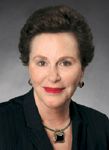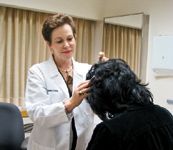- Acne
- Actinic Keratosis
- Aesthetics
- Alopecia
- Atopic Dermatitis
- Buy-and-Bill
- COVID-19
- Case-Based Roundtable
- Chronic Hand Eczema
- Chronic Spontaneous Urticaria
- Drug Watch
- Eczema
- General Dermatology
- Hidradenitis Suppurativa
- Melasma
- NP and PA
- Pediatric Dermatology
- Pigmentary Disorders
- Practice Management
- Precision Medicine and Biologics
- Prurigo Nodularis
- Psoriasis
- Psoriatic Arthritis
- Rare Disease
- Rosacea
- Skin Cancer
- Vitiligo
- Wound Care
Article
Dermatologist employs lifelong motto to achieve goals, dreams
Author(s):
At age 32, having just become a board-certified dermatologist, Wilma Fowler Bergfeld, M.D., was already feeling antsy about what she would tackle next. So, she set goals one lonely night at her desk, and decided that she would become the first female president of the American Academy of Dermatology (AAD).

Key Points
Wilma Fowler Bergfeld, M.D.
Born:
Philadelphia
Medical degree:
Temple University Medical School Philadelphia
Fellowship, dermatology:
Cleveland Clinic Foundation
Earl Osborne Dermatopathology Fellow
Hobbies:
"Caring for my family," reading, sailing (she holds a captain's certificate) and downhill skiing
Family:
Husband, orthopedic surgeon John A. Bergfeld, M.D.; two daughters (one deceased); five grandchildren

She asked herself how she would get there, answering with what has become her motto: Preparation, preparation, preparation.
"I became president of almost everything I had gotten involved in. And, by my 50s, I had done it all," Dr. Bergfeld says.

Career highlights
Among her many career highlights, in 2007, Dr. Bergfeld was honored with the prestigious Founders Award, the highest award given by the American Society of Dermatopathology (ASDP). She was simultaneously elected president of the ASDP, just finishing that appointment in October 2009. Dr. Bergfeld also has been called a pioneer for her work in hair loss.
"When I first joined the department of dermatology, in 1969, no one wanted to see the hair-loss patients; so, I was assigned to them," she says. "I found hair to be extremely challenging, and it was a subspecialty of dermatology which was neglected."
Over her 42 years in dermatology, Dr. Bergfeld has garnered broad experience, authoring several clinical papers and many book chapters about hair disorders.
She emerged as one of the top hair-loss clinicians and researchers in the United States, founding the North American Hair Research Society, which evolved into the Intercontinental Hair Research Society, an international group of hair research scientists from the United States, Europe and Asia.
"I am not a solo therapist; I use multiple types of therapies, including nutritional, topical, systemic therapies. And my patients tend to get better with treatment," she says.
Dr. Bergfeld says that while president of the AAD, in 1992, she became known as the communications expert. Dermatologists were coming under fire during the silicone controversy involving cosmetic surgeons. Dermatologists, according to Dr. Bergfeld, were injecting silicone into patients' faces, and the media and consumers wanted to know why. In addition, the Food and Drug Administration (FDA) demanded that the practice be halted.
"In January, the television news show '20/20' wanted us; the FDA wanted us. We were on the firing line, and I was able to walk us through that storm (by communicating)," she says.
Preparation, preparation, preparation, came into play, according to Dr. Bergfeld, who says she drew on her leadership experience with different organizations to successfully manage the crisis.
Women's advocate
Dr. Bergfeld was founding president of the Women's Dermatologic Society. One of her goals, she says, is to ensure that women are leaders in the specialty.
Her mission as president of the ASDP was to spur the society, which she says was grounded in tradition, to become more competitive in the professional society marketplace.
"They had not changed any of their behavior for 40 years," she says. "I did a governance review with the help of the board and a facilitator, and we brought them into the 21st century."
Newsletter
Like what you’re reading? Subscribe to Dermatology Times for weekly updates on therapies, innovations, and real-world practice tips.











